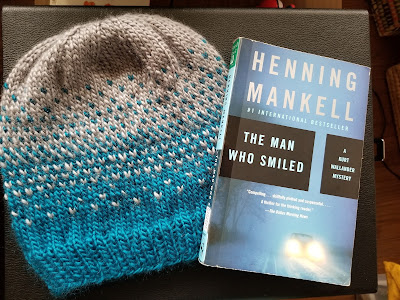The Quick Ombre Hat and the Man Who Smiled
The knitting: The Quick Ombre Hat by Emily Dormier
The novel: The Man Who Smiled by Henning Mankell
I'm not a big colorwork knitter, but I'd like to be. I knew I had yarn that matched this cover, so I hoped this pattern would be a good practice. I feel like I have a ways to go with holding my yarn at the right tension, but this was fun to work with. This hat is going in the donate pile, and I think I have enough of the skeins to make a second hat.
The yarn, by the way, is Vicki Howell Sheep(ish). I got it from a friend's destash and I think it will hold up okay. It's only 30% wool, but since it's roving it knits up nice and fluffy.
I really enjoyed the pattern and the yarn, but I don't love how different the stitches look in some places. I'm not sure if it's something nonknitters will notice, or if they will and think it's something I did intentionally. I went down to a Size 7 needle from the recommended Size 8, but this turned out larger than expected. But apparently some charities have a greater need for larger hats because there are more donations of baby and kid hats, so I'm pretty pleased about that.
So. The Man Who Smiled. This particular Kurt Wallander mystery is especially Wallander-y. It starts about a year after everything that happened in The White Lioness. Kurt hasn't returned to work and is trying to outrun his trauma with travel and drinking. He's decided to retire and take beach walks for the rest of his life when his old friend, Sten Torstensson, asks him to look into the death of his father, Gustaf. Then Sten dies. Then Wallander decides to return to work.
Some things at the workplace are the same--the regular gang of Nyberg, Svedberg, and Martinsson are good solid detectives. Bjork frets about public perception. Hanson is a jerk. Ebba mans the phones. And there's a new hire named Anne-Brit. A woman! Who is younger than the rest of the team! This book was published in 1994.
It turns out Gustaf, provincial lawyer, handled a lot of the affairs of internally known rich person Alfred Harderberg. Spoiler: he is the villain. He's a rich person with no accountability and he smiles too much. Of course he's going to do illegal things. Old Gustaf figured it out when working with some council member in another community who he met through a religious icon-collecting club. I've read this book twice and watched the TV episode with Kenneth Branagh at least half a dozen times and I still couldn't tell you how Wallander and his team make the connection. This story has a bunch of twists and turns and a lot of people whose first or last name ends in "-son". Sometimes both of their names end in "-son". I love it.
I promise this is a nuanced examination of the ways being impressed by wealth and power insulates the wealthy and powerful with even more wealth and power. Wallander knows that something is changing in the world--in police work, in the types of crime being committed, in technology--but he doesn't know what. He worries about his dad. He thinks about the necessity of abasing himself before the rich and powerful even as he wields a ton of power over people as a member of the police. He really should check on his daughter more. She's away apprenticing for a furniture upholsterer in this one.
But there's also exploding cars, tense nights, and everyone's favorite alcoholic horse trainer from Wallander's past, Widen. Widen always comes through. And Wallander stops the evil smiling Harderberg from flying away in a private plane by driving a luggage tractor straight at it before jumping out at the last minute. And he goes back to that airport on Christmas Eve to pick up Baiba who has come to visit.
This was super-satisfying. Wallander and his colleagues argue over procedure. Wallander and his dad argue over everything. Everyone drinks a lot of coffee. It's great.






Comments
Post a Comment